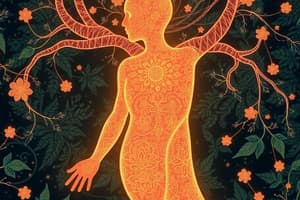Podcast
Questions and Answers
What ecosystem do humans serve for microorganisms?
What ecosystem do humans serve for microorganisms?
An important ecosystem
What is a microbiome?
What is a microbiome?
- The sum of all microorganisms and microbial genomes that constitute a host's normal microbiota (correct)
- A synonym for viruses
- All types of microorganisms in a habitat
- Only harmful bacteria in the human body
The microbiota is part of the host's second line of defense against harmful infectious agents.
The microbiota is part of the host's second line of defense against harmful infectious agents.
False (B)
When does the microbiota community begin developing?
When does the microbiota community begin developing?
Which of the following factors can affect the development of a stable microbiome?
Which of the following factors can affect the development of a stable microbiome?
What type of bacteria predominates in breast-fed infants?
What type of bacteria predominates in breast-fed infants?
What happens to Bifidobacteria dominance when starting solid food?
What happens to Bifidobacteria dominance when starting solid food?
The six major phyla of bacteria in the human microbiota include Actinobacteriota, Bacteroidota, Firmicutes, Fusobacteriota, Proteobacteria, and ________.
The six major phyla of bacteria in the human microbiota include Actinobacteriota, Bacteroidota, Firmicutes, Fusobacteriota, Proteobacteria, and ________.
Internal organs and tissues such as the brain and blood are usually colonized by microorganisms.
Internal organs and tissues such as the brain and blood are usually colonized by microorganisms.
What can continuous skin contact with the environment lead to?
What can continuous skin contact with the environment lead to?
Flashcards are hidden until you start studying
Study Notes
Microbe-Human Ecosystem
- Humans serve as a significant ecosystem for microorganisms with an equal number of somatic and microbial cells in an average adult.
- The microbiome encompasses all microorganisms and their genetic material, portraying its vital role in human health.
- Normal microbial flora (microbiota) refers to the microbes typically associated with the human body.
Holobionts and Metabolome
- Holobionts consist of hosts and microbes co-evolving to function as a single organism.
- The metabolome includes all small molecules produced by a cell, contributing to cellular functions.
Microbiota Interactions
- Interactions between human hosts and microbiota are primarily mutualistic (beneficial) or commensalistic (neutral).
- Microbial niches vary due to factors like age, gender, diet, and nutrition, highlighting the complexity of the microbiome.
Development of a Stable Microbiome
- The microbiome begins developing at birth, reaching stability by age three; diverse microbiomes are linked to better health.
- A variety of factors influence the establishment of a stable microbial community within the human body.
Early Colonization
- Newborns are colonized primarily through vaginal birth, which exposes them to maternal microbes; cesarean delivery results in different microbial exposure.
- Bifidobacteria dominate the intestinal flora of breast-fed infants, aided by sugars in human milk that encourage the growth of non-pathogenic bacteria.
Adult Human Microbiota
- The adult microbiota is relatively stable but can change due to lifestyle and environmental factors, showing variability among individuals and different body sites.
- Key bacterial phyla found in humans include Actinobacteriota, Bacteroidota, Firmicutes, Fusobacteriota, Proteobacteria, and Verrucomicrobiota, along with some archaea, fungi, and viruses.
Microbial Presence by Body Site
- Normally, internal organs (including the brain and muscles) are free from microorganisms, while the skin and mucous membranes are populated with various microbes.
- The skin acts as a robust barrier against microbial invasion, with keratinocytes forming a dense outer layer that few microbes can penetrate.
Studying That Suits You
Use AI to generate personalized quizzes and flashcards to suit your learning preferences.




